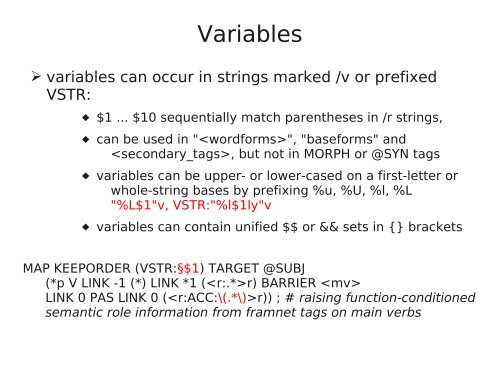On how to write rules in Constraint Grammar (CG-3) - VISL
On how to write rules in Constraint Grammar (CG-3) - VISL
On how to write rules in Constraint Grammar (CG-3) - VISL
You also want an ePaper? Increase the reach of your titles
YUMPU automatically turns print PDFs into web optimized ePapers that Google loves.
Variables<br />
➢ variables can occur <strong>in</strong> str<strong>in</strong>gs marked /v or prefixed<br />
VSTR:<br />
$1 ... $10 sequentially match parentheses <strong>in</strong> /r str<strong>in</strong>gs,<br />
can be used <strong>in</strong> "", "baseforms" and<br />
, but not <strong>in</strong> MORPH or @SYN tags<br />
variables can be upper- or lower-cased on a first-letter or<br />
whole-str<strong>in</strong>g bases by prefix<strong>in</strong>g %u, %U, %l, %L<br />
"%L$1"v, VSTR:"%l$1ly"v<br />
variables can conta<strong>in</strong> unified $$ or && sets <strong>in</strong> {} brackets<br />
MAP KEEPORDER (VSTR:§$1) TARGET @SUBJ<br />
(*p V LINK -1 (*) LINK *1 (r) BARRIER <br />
LINK 0 PAS LINK 0 (r)) ; # rais<strong>in</strong>g function-conditioned<br />
semantic role <strong>in</strong>formation from framnet tags on ma<strong>in</strong> verbs
















